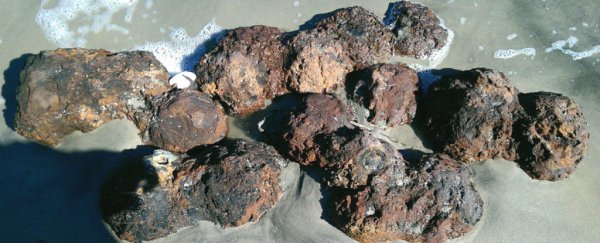The US Air Force Explosive Team was called onto a beach in South Carolina over the weekend to deal with a rather unexpected result of the hurricane-force winds that have been tearing across the US Southeast coast and the Caribbean.
On Sunday morning, a local reported the discovery of 16 Civil War cannonballs on a Folly Island beach near Charleston, that had been unearthed by Hurricane Matthew. The bomb squad proceeded to detonate them with a small amount of explosives right there on the site.
Most of the 150-year-old ordnance was destroyed on the beach, but some were able to be transported safely back to the local navy base for disposal.
"We call it 'rendering safe', and we did that right there on the beach front," Eric Watson, a spokesman with the Charleston County Sheriff's Office told the press. "They're putting the dirt from the detonation back in the hole and they're transporting the device to (Joint Base Charleston)."
Of course, nothing's ever simple when it comes to handing weird, ancient explosives, and in this case, the team had to wait for more than 6 hours for the tide to give them space for the detonation.
"We had to wait until after 7[pm] for the tide to go down," Watson told Mary Bowerman at USA Today. "When the tide receded, our guys and members of the US Air Force explosive team used a small amount of C-4 to detonate the cannonballs."
The site is just 20 km (12.8 miles) from Fort Sumter in Charleston, where the first shots of the Civil War were recorded at the First Battle of Fort Sumter on 12 April 1861.
As Linda Wheeler reports for The Washington Post, the 18-square-km (7-square-mile) Folly Island had been used as a Union fort at the time, and also staging area for attacks on Confederate strongholds.
So it's no surprise that a number of Civil War discoveries have been unearthed on the island, including an unsettling find in 1987, when construction workers unearthed the remains of 14 soldiers from the 55th Massachusetts regiment of the US Coloured Troops - most of which were missing their heads.
"What was odd about the bodies discovered on the island was that 12 of them didn't have skulls and were also missing other body parts," says Wheeler.
"And, more importantly, they showed no signs of battle injury, according to an account in an official history of Folly Island. What happened to these men was then and still is a mystery."
Just in case you were looking for more US icons that ended up in strange places during the hurricane, witness the most photogenic bald eagle in the world, that had wedged itself in a car near Green Cove Springs, Florida during the storm:
Clay County Sheriff’s Office says bald eagle is okay after getting stuck in the grille of an oncoming car pic.twitter.com/BMVY33n0mr
— ABC News (@ABC) October 8, 2016
But don't worry, the eagle was freed and unharmed.
